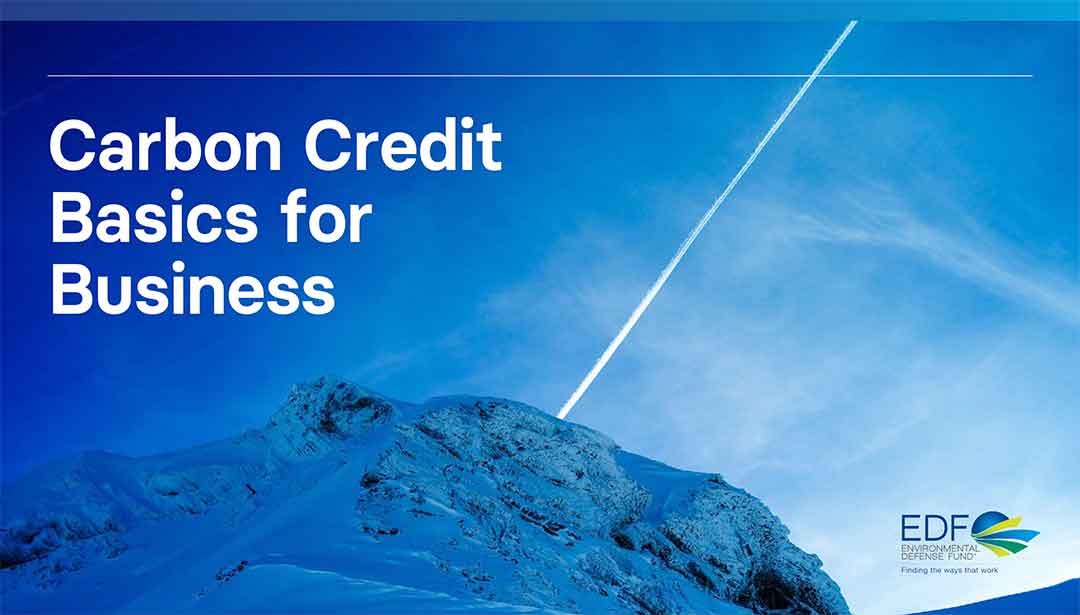New guidance for companies drives quality and integrity in the complex world of carbon credits
Voluntary carbon markets are booming as companies look to finance emissions reductions or removals as part of their net zero strategy. In 2021, the market hit a new milestone by crossing $1 billion in transactions.
The quality of a carbon credit is paramount to ensuring it contributes to global net zero and sustainable development. Thankfully, new guidance from EDF and partners can help companies cut through the noise, identify high integrity, high quality credits, and invest with confidence.
Scaling quality for tropical forest carbon credits
We won’t avoid the worst impacts of climate change without protecting tropical forests. Companies are key to unlocking the financing needed for forest protection and restoration while supporting and respecting the rights of Indigenous peoples and local communities. Yet while forest carbon credits account for more than 50% of the market, there has not been clear guidance for businesses on how their investments can help drive the supply of high-integrity tropical forest credits.
Over the past year, EDF along with leading nonprofit organizations, Indigenous Peoples’ organizations, and research institutions have come together to address this gap, and identify guidance that can play a critical role in ensuring that companies help raise the global bar for tropical forest credits and drive the market toward high-impact approaches through their investments. The result is the newly released Tropical Forest Credit Integrity Guide for Companies (TFCI Guide).
The five key recommendations for companies purchasing tropical forest carbon credits are:
- Rapidly evolve credit purchasing portfolios to include an increasing share of credits from jurisdictional-scale programs (which issue credits generated across a country, state, province or territory). Financing credits on a jurisdictional-scale can support the long-term structural changes necessary to end deforestation.
- Prioritize the purchase of credits from programs and projects that reduce threats to standing tropical forests. If lost, much of the carbon stored in tropical forests, peatlands and other ecosystems is “irrecoverable” through restoration by midcentury. A narrow focus on carbon removal misses the forest for the trees (pun intended!) on a critical climate opportunity.
- Be transparent, and align reporting of credit purchases with emerging Paris Agreement accounting requirements. That means that companies should publicly report key details around their credit purchase, including the project, program and host country; how the credits will be used; and whether the credits are associated with a corresponding adjustment. This is particularly important as carbon market standard-setters deliberate the implications of the agreement made at COP26 on global carbon market cooperation.
- Purchase carbon credits as a complement to—not a substitute for— deep decarbonization using science-based targets. Internal decarbonization is a non-negotiable in companies’ net zero strategies – but these investments beyond the value chain are critical to reaching global net zero, and deliver a host of co-benefits for people and nature.
- Meet rigorous environmental quality standards when purchasing high integrity tropical forest credits, and look to programs that support the full and effective participation of Indigenous Peoples and Local Communities. This helps ensure that private sector investments are fully respecting their rights and distributing to them an equitable share of benefits.
There are opportunities now for companies to help bring high-quality jurisdictional carbon credits to market. One example: the LEAF Coalition, which has already mobilized $1b in financing for tropical forests through a partnership of 20 major global businesses and the governments of the US, UK and Norway. In aggregate, companies that join the LEAF Coalition can help send a clear demand signal for quality and integrity in the voluntary carbon market.
New guidance can help shift the credibility landscape
A number of other credit quality initiatives are soon to bring additional clarity to the market.
The Carbon Credit Quality Initiative (CCQI), a collaboration between EDF, the World Wildlife Fund and the Oeko-Institut, will soon launch an open-access, interactive tool where buyers can compare different carbon credit project types. This can help buyers determine the likelihood that their investments drive the highest possible climate impact and contribute to positive sustainable development outcomes. The tool will build on CCQI’s rigorous scoring methodology, and will initially feature quality assessments of three project types and four carbon credit programs. Moving forward, the initiative looks to assess more project types and programs to generate more scores for credit buyers.
Additionally, in the coming weeks, two influential initiatives – the Voluntary Carbon Market Integrity initiative (VCMI) and the Integrity Council for the Voluntary Carbon Market (IC-VCM) – will release drafts of highly-anticipated guidance. While the VCMI focuses on how companies can make high-impact claims around their use of credits, the IC-VCM will establish key quality benchmarks for credits. In order for companies to maximize their climact impact, it will be essential for companies to understand the implications of this guidance for their net zero strategy.
A much-needed accelerant for climate action
We are running out of time to secure a liveable and stable climate. And we’re running out of time to protect one of the most important carbon sequestration tools the planet has: tropical forests. Driving the funding necessary to keep forests standing is key to making sure that trees are worth more alive than dead. With this new guidance, companies can better ensure that their engagement – and investment – in carbon markets supports the outcomes we need to drive real results for the climate and communities around the world.
